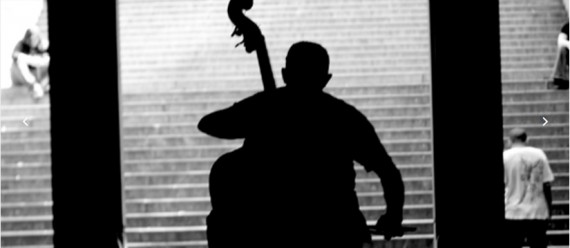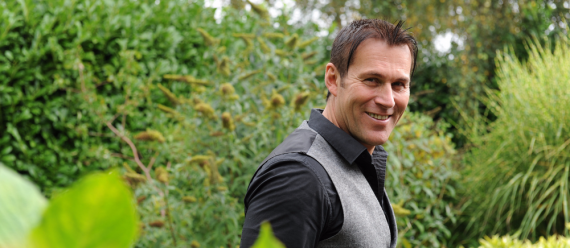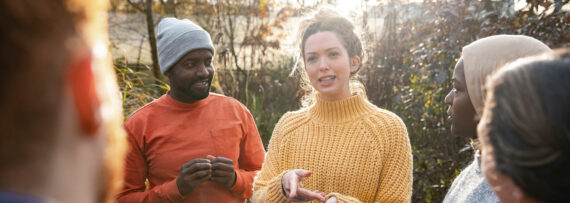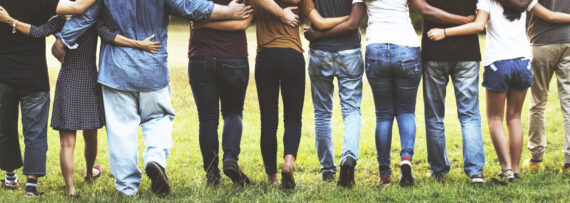Family Therapist Susan Schwartz Senstad provided psychotherapy for over 20 years. In 1986, she introduced Voice Dialogue in Norway, where she has trained many consultants, teachers and therapists as facilitators. Three years ago, she closed her practice in order to write full time. Her prize-winning first novel, Music for the Third Ea, which has been published in five countries including the U.S. , is about a couple seeking refuge from the war in Bosnia.
Now, in collaboration with Dr. Beverly Allen, Senstad has written DARING TO TRUST:
Life Lessons >From Women in Bosnia, a book about resilience based on interviews with women in Bosnia. The following text is adapted from a lecture she held at the Norwegian Palliative Association, Sandefjord, Norway, 30. August, 2001. It has been published as “Smertens verdi” in Nordisk Tidsskrift for Palliativ Medisin, vol.19, nr. 1, March 2002 and, in a somewhat different form in The Literary Review, vol. 45, Nr. 4, Summer, THE WISDOM OF VULNERABILITY by Susan Schwartz Sentstad.
I knew when I agreed to discuss vulnerability and the value of pain that the theme has far-reaching implications. Unfortunately, since the heinous acts in New York and Washington the 11th of September, the topic has also taken on a great urgency. Geopolitical and personal security require vigilance on two fronts: physical safety and respect for vulnerability. In these times of terrorism, it would be easy to allow the former to overshadow the latter. If we do that, however, we risk becoming complicit in increasing the danger we are already in. One value of pain is that it offers the possibility for the acknowledgement of vulnerability, which then can become a source not only of tolerance and love but also of personal and political security. To look more deeply into that, I’ll begin at the individual level, because it’s there that world history begins. Later, I’ll widen the perspective to look at the important impact on society exerted by the work of those who care for terminally ill people and their families.
It is no wonder that vulnerability is a hard commodity to market; it’s usually associated solely with the shameful exposure of weakness. I prefer to use the definition Drs. Hal and Sidra Stone have written in their excellent book, Partnering. To be vulnerable, they explain, is to be without defensive armor, to be authentic and present.
‘When we are able to feel our vulnerability, we are able to experience the full range of our reactions to the world around us… – our physical needs, our craving for intimacy, and all our more sensitive feelings including our loves, yearnings, fears, shyness, insecurities, and discomforts.’ (p.101)
A Norwegian theologian, Sturla Stålsett, and some of his colleagues have written a wonderful pamphlet called “Vulnerability and Security.” In it, they describe the same thing in their own way:
‘Vulnerability is the unique capacity for receptivity and empathy which allows human beings to acknowledge and care for their ethical responsibility for each other, for the community and their environment. Against this aspect of vulnerability, we ought not protect ourselves. On the contrary, it is a necessary precondition for the kind of security that isn’t only about me and mine, or us and ours, based on some implicit assumption that might makes right.’ (p.8-9)
I learned something about the value of vulnerability with one of the people who meant the most to me: my father.
We seem to specialize in what we need: I didn’t become a family therapist for no reason. My father was a very good person, but also a man of his times, a good-hearted patriarch, a benevolent dictator. ‘Daddy is a lot like God,’ my sister and I used to say, ‘except that God is easier to make contact with.’ Daddy presented himself as strong, self-assured, decisive – and totally invulnerable.
Imagine then, what a shock it was to discover that he had pancreatic cancer and only a short time left to live. He was only sixty-three, and I thirty-three. How should I help him-me with all my family therapy competence?
On the one hand, I thought, my role might be to motivate him to fight against his illness. Surely an all-powerful man such as he could win over death, if he really wanted to. Weeping, I read to him from Dylan Thomas, “Do not go gentle into that good night,/rage, rage against the dying of the light.”
Or perhaps my job was to help him reconcile himself to death. But how to do that when he’d never shared his worries with me? And how to do that when our whole family was far more attached to the myth of his omnipotence, and far more active in imprisoning him in that myth, than any of us wanted to realize.
‘But, what if you have no job to do in connection with your father’s dying?’ a friend of mine protested. ‘What if you could just talk to him like a daughter?”
That’s what I did. I pulled a chair up to his hospital bed and said, ‘Daddy, I love you. Please don’t go.’ I lay my head on his chest and he stroked my hair for an entire half an hour. We were so lucky: we both cried. I got my father, one week before I lost him.
What had happened? Pain had given us the gift of breaking through what Stålsett and his colleagues call our shared ‘dream of invulnerability,’ and that had opened the way for love.
***
A few clarifications are in order here: I am not idealizing suffering; this is no paean to masochism. Nor am I out to discourage practitioners from alleviating patients’ pain that they might harvest of their precious vulnerability. Rather, this is about recognizing the gifts that vulnerability can offer.
Nor am I distinguishing here between physical and psychological pain — even though they differ profoundly. As Elaine Scarry points out in her important book, The Body in Pain, physical pain lies outside the realm of language; it has no object — is not about anything other than itself but rather simply is. As such, it is has the power to wipe out the whole spectrum of psychological affect, everything from pleasure to misery.
There is, however, no physical pain without a psychological consequence. Sometimes, when physical pain is the expression of repressed psychic pain, the two conflate. We call being love-sick having a ‘broken heart’ because our nervous system communicates hurt feelings and a hurt body along exactly the same chemo-electrical circuits. I remember looking down at myself on the day the divorce from my first husband became final and being totally amazed that my blouse wasn’t dripping with blood, the emotional pain was that physical.
The most important reason not to make a distinction between physical and emotional pain is to avoid being seduced by an illusory body/mind split. There was a pole at the old Central Hospital in Oslo that had twenty-some-odd signs on it with arrows pointing: eyes over here, throats over there, hearts that way, intestines around the corner. It may seem at times as if the great medical project were to succeed at repairing all human parts without having to deal with any human beings.
In some ancient cultures, the body/mind split concept is part of a path to loving all living things; mind control is cultivated as a protection against being swayed by every raging emotion. For our culture, however, it easily becomes a form of splitting, an instrumentalizing dualism, an attempt to bring nature under man’s control, as if that were unquestionably a good aim to have – an expression of the dream of invulnerability.
***
The fact that vulnerability may be a positive thing which requires openness does not mean, however, that people would do well to go around without any armor. We ought all be equipped with a set of good, strong, well-functioning defense mechanisms, because we need them. Behind the armor of our socialized ego lie aggression, greediness, passions unchecked by morality. Just visit a child care center if you care to see how brutal our uncivilized, primitive impulses were before they came under our conscious control. Under our armor lie our reactions to all new and old trauma — wounds from losses, fears, shocks, humiliations, failures, abandonments — the emotional baggage we carry with us from childhood on. To contain all this, we need our defenses. Children without defense mechanisms can end up as institutionalized cases. Nor does lability, a continual swinging from one strong emotion to another, make for a happy life.
But the pursuit of mastery and control, the attempt to avoid all pain, acts as a lock preventing us from opening vulnerability’s treasure chest. As Drs. Stone write, ‘The paradox is that if we don’t have access to vulnerability, we don’t know who we are or what we like or don’t like, what makes us happy or sad.’ Just try to be playful with your defenses in high gear, or creative. Even worse, try making loving, passionate love with your armor locked – a guaranteed fiasco. Without access to vulnerability we lack the capacity for empathy, and to develop our own sense of ethics. If we don’t have access to our vulnerability, every encounter becomes a power play, a struggle over control and status.
As I learned by my father’s deathbed, it was only when we both could bear our own and each other’s vulnerability, when we were willing to confront the fact that he was ‘only’ a mortal, vulnerable human being, that the two of us could really meet, soul to soul. The gift of pain.
***
Too much control is inhibiting, too little is chaotic. Too much vulnerability is frightening, too little is tragic and lonely. We need both mastery and openness, both protection for our boundaries and the ability to surrender them. The problems start when we define that as an either/or and choose only control. At its worst, the either/or thinking involved in a total denial of vulnerability is a diagnostic red flag. The use of the defense mechanisms of splitting and denial can point to borderline character disorders. Fortunately, most of us are not suffering from such disorders. More often than we may like to admit, however, we do avail ourselves of borderline-style defenses.
For example, we may deny about our patients’ vulnerability:
We may covertly encourage our patients’ to display exaggerated bravery such that they end up feeling shame for having disappointed us, for not being as courageous as we’ve unconsciously signaled to them that we need them to be.
We may objectify them, focusing intensely on the technical side of their suffering.
We may harbor a secret narcissism in our longing to alleviate all suffering, a so-called “healing mania.”
We may even get angry when patients fail to confirm our omnipotence by insisting on remaining ill, such as when they prove us powerless to lighten their loathing of their cancer-ravaged bodies.
Another way we may protect ourselves using borderline-like defenses is by disowning our own vulnerability:
We may use our competence and our scientific rationality like a shield.
We may exhibit an unconscious need to keep the role assignments clear: the patients have to be vulnerable while we get to be strong. Helen Bamberg, who started The Medical Center for the Care of Victims of Torture in London and who, herself, survived the concentration camp at Bergen-Belsen, tells how the helpers who cared for liberated camp prisoners did just fine. Until, that is, the freed prisoners got stronger, started having opinions of their own, and what’s more, started challenging the staff’s authority. That made the helper anxious ergo furious; they’d lost their monopoly on strength.
We may behave as if our energetic resources were boundless and then over-estimate how much work we can responsibly take on. Just recently, two nurses working the second part a double-shift slept through the intensive care alarm as a female heart patient lay dying. Sometimes it seems as if health service administrative policies rely on, even exploit, the staff’s denial of its own vulnerability. I maintain that burn-out is in large part a result of long-standing neglect of vulnerability.
Here’s a list of questions, inspired by Drs. Stone, to check out if you are treating your own vulnerability respectfully:
- What do you do that you don’t really want to do?
- What don’t you do that you really wish you could do?
- When did you last do something you didn’t really want to do, just to keep the peace?
- When did you last quit doing something you really liked doing because you wanted to satisfy someone else.
- When have you forced yourself to go beyond your physical limits: by continuing to work long after you were already exhausted; by skipping meals; by forgetting to take a break even though you needed one; by sitting for hours at your desk without changing positions; by not getting enough sleep?
- When have you neglected your own feelings while you: made love; were in pain; felt discomfort; felt afraid; felt shy; felt overwhelmed?
- Must you always do something; are you unable to simply be with a suffering person because you need distractions from how emotionally stirred up that makes you feel?
- All these behaviors are ways to put a lock on one’s armor, not to embrace vulnerability.
***
At this point, I’ll take what may seem like a leap from the personal to the geopolitical and speak about Bosnia, because it is there that I learned just how dangerous it can get when vulnerability is disowned. I’ll be using Bosnia as an example, but such dynamics are repeated the world over.
Even now, six years after “peace,” after the Dayton Accord, the wounds are deep in Bosnia-Herzegovina – in the landscape, the buildings, the human beings. As a therapist, I’d seen individual pain up close, but never before had I been immersed in and surrounded by an entire region trembling with the after-effects of mass destruction, war and evil. All I could do was howl the existential question: How can people do this to each other?
Though the great puzzle of evil remains unsolved, the concept of the ‘dream of invulnerability’ does help put some pieces into place. As I see it, every form of fundamentalism – be the fanaticism Christian, Jewish or Muslim, Nazi, Fascist or Communist, or just in the name of ‘patriotism’ – provides an illusory security. Rather than experiencing how we hate and fear our own vulnerability, we try to get rid of the shame we feel regarding what we define as weakness by dividing the world into the good and the evil, the strong and the weak, the righteous and the infidels; then we place ourselves, ’securely,’ among the good/strong/righteous. Because the disowning of vulnerability makes empathy impossible, we’re now free to treat the evil/weak/infidels as totally unlike us, as hardly human. From there, and with ’God on our side,’ it is but a short step to attacking these ’monsters,’ using violence. Obviously, these ’Others’ feel righteous in avenging our attacks. The cycle of violence has begun. Thus, it is precisely what we do to protect ourselves, search for invulnerability, that becomes the source of our own destruction.
To see how such denial of vulnerability makes us easy prey for all kinds of fundamentalists and speculative tyrants, just look with what slick ease Slobodan Milosevic played upon such self-aggrandizing, other-hating chords within the Serb culture and in otherwise good Serb people.
Sadly, it is true that all sides in the Bosnia war committed atrocities. All the victims on all three sides deserve our empathy just as all the war criminals on all three sides deserve to be brought to justice before the Tribunal. But it is indisputable that the Serbs committed the most crimes, and that only the Serbs had rape and genocide as their systematic, strategic policy.
As Branimir Anzulovic writes in his book, Heavenly Serbia: From Myth to Genocide, “…the primary driving force leading to genocide is not the pathology of the individuals organizing and committing the genocide, but the pathology of the ideas guiding them. These ideas are often produced and propagated by relatively normal people who may be unaware of the consequences of their escape from reality into myth.” (p.4) Many of the myths which permeate the Serb culture and religion, Branimir writes, carry utopian promises of a perfect society which can only be achieved though by the extermination of those groups accused with obstructing that society’s emergence.
Also relevant to the Serb culture are the theories of psychoanalyst Alice Millers, from her book For Your Own Good: Hidden Cruelty in Child-rearing and the Roots of Violence. She traces German susceptibility to systematic cruelty to authoritarian parenting practices in which children are beaten, berated, ridiculed and shamed. In other words, their vulnerability is violated. That’s more than enough to create vengeful adults, “willing executioners” as author Daniel Goldhagen called them. A new handbook about more humane methods to raise and teach children has been gratefully received in the Balkans; apparently, the longing for a kinder society is quite strong.
***
To our surprise, Dr. Allen and I came upon a model for what the citizens of warring societies need to learn if they are to achieve peace when we visited the UN International War Crimes Tribunal for the former Yugoslavia in The Hague. There, we interviewed the people responsible for protecting witnesses both for the prosecution and for the defense of accused war criminals. We asked some of the Witness Protection employees how they managed to treat all witnesses fairly and with respect, even those who most likely were mass-murderers and rapists. They described a process of acknowledgment of their own personal vulnerability – the opposite of denying it. Once they allowed themselves to bear the pain of their own horror, anger and revulsion, they were free to set their belief in human rights and justice above their impulses toward vengeance. Had they not admitted to themselves their darker feelings, those might well have got the upper hand. That is: they could control their feelings because they dared to feel them.
‘People who are clear about their own vulnerability,’ Stålsett and his colleagues write, ‘will more often pursue cooperation than confrontation and conflict. This simple observation is also valid on an international level…History is full of examples, of the fact that the idea that a person, nation, region or “civilization” can be secured against any and every form of vulnerability actually leads to an escalation of conflicts and brutality in human relations.’ (p.36 & 14) One would hope that all the governments preparing to avenge terrorism might keep that fact in mind.
***
Our journeys through Bosnia-Herzegovina shook my soul, but opened my eyes. Beverly Allen and I interviewed people from all three warring groups, in all sorts of life situations and from a variety of social classes. Two particular interviews, one immediately after the other, made a deep impression on us and are a lesson in the importance of vulnerability.
The first was with a Muslim peasant who had been gang-raped during the war by her Serb neighbors while her ten-year old son was forced to watch. She is married to a man who himself survived merciless torture. When we asked the woman about feelings of vengeance, she said, sadly and soberly, that she hoped those who committed the crimes would be brought to trial. She did not, however, blame all Serbs.
All the while, as she recounted the details of her torment this woman stroked the wispy, dark hair of her 3-year old daughter who was resting on her lap, caressing the child slowly and tenderly. The contrast between the images of atrocities her words created and the sight of her loving gestures was almost unbearable. How did that one body of hers contain, simultaneously, those two realities? This is precisely what not splitting looks like.
Our next interview was with an educated Bosnian Serb woman in Banja Luka, the ‘ethnically cleansed’ capital city of the Republika Srbske. This woman survived the war without significant loss or injury. As opposed to most of the other woman we interviewed, this one spoke with bitter hatred about Muslims. And about U.N. soldiers who had arrested indicted Serb war criminals while their children watched – which this woman, with a total lack of perspective, considered a most horrifying abuse. This interview was also hard to bear, but now because the woman was so closed, so clenched-hearted in her denial of the crimes committed in her peoples’ name.
For which of these two women is the prognosis for living out a more-or-less normal capacity for love best? My guess, ironically, it that it’s the victim. She seems to be in the midst of a healing process while the other woman seems to be in a frozen avoidance of one.
***
Some say that we must be careful not to ascribe a collective guilt to all citizens in a war-mongering dictatorship. Enver Djuliman of the Norwegian Helsinki Committee responds to that question in his article, “The Difficult Reconciliation.”
‘Citizens bear responsibility for what a dictator does since no dictatorship can be maintained without the tacit agreement of the people. It is also the case that the people have re-elected the very regimes that have committed the worst offenses, and done so several times. Does personal responsibility stop there? Or are people also responsible for the kind of prevailing atmosphere in a society which is required for the establishment of criminal regimes.’ [italics mine] (p.7)
This brings the topic home. For now it becomes clear just what a radical force the work of all caretakers and therapists may be. Of course, leaders always bear more responsibility than do those they lead. However: The way we live our personal lives has repercussions on our world. When we embrace and respect both strength and vulnerability, that of our patients’ as well as our own, we impact on society’s “prevailing atmosphere” such that we contribute to the prevention of “the establishment of criminal regimes.”
Dr. Nigel Sykes of the St. Christopher’s Hospital in Britain said that people perform a public health function by engaging in a family’s experience of death. They help shape not only the relationship of that family to death and dying, but that of the entire culture, and of generations to come.
So it is with the honoring both vulnerability and strength: we each help to vaccinate society against intolerance, hatred and war when we bear to be present with a suffering person, in strength and in softness, listening and feeling. May peace begin here.
References:
Allen, Beverly. Rape Warfare: The Hidden Genocide in Bosnia-Herzegovina and Croatia. Univ. of Minnesota Press, 1996
Anzulovic, Branimir. Heavenly Serbia: From Myth to Genocide. Hurst & Co., London, 1999
Djuliman, Enver. “The Difficult Reconciliation” title article of anthology: The Difficult Reconciliation, Enver Djuliman, ed. The Norwegian Helsinki Committee, 2001.
Goldhagen, Daniel Jonah. “Hitler’s Willing Executioners: Ordinary Germans and the Holocaust.” Abacus/Little, Brown & Company, U.K., 1997
K.I.S.P. (The Committee for International Questions of the Interchurch Council for the Norwegian Church, Sturla Stålsett, leader). Vulnerability and Security: Current Geopolitical Security Challenges from an Ethical and Theological Perspective. Den Norske Kirken, 2000.
Miller, Alice. For Your Own Good: Hidden Cruelty in Child-rearing and the Roots of Violence. Virago Press/Little, Brown & Company, U.K., 1987.
Scarry, Elaine. The Body in Pain. Oxford University Press, New York, 1985.
Senstad, Susan Schwartz. Music for the Third Ear. New York: Picador/St. Martin’s Press, 2001. Other editions and translations: London: Anchor Books/Doubleday, 2000. Muziek voor het derde oor, Amsterdam: Arena, 2000. Musikk for det tredje øre, Oslo: Pax forlag, 2000. Das Nullkind, Munich: Deutscher Taschenbuch Verlag, 2002.
Stone, Hal, Ph.D. and Sidra, Ph.D. Partnering: A New Kind of Relationship. New World Library, Novato California, 2000.
On 9/11/2002, Drs. Hal and Sidra Stone sent this article out via email before Susan Schwartz Senstad had a chance to update the references information about the various translations of the novel she’s written. This is to let people know that those whose mother tongue is Dutch, German or Norwegian or those English language readers outside the U.S. and Canada can also get the novel in their own countries and language, as follows:
In English in Europe, Australia, etc. – in all countries besides U.S. and Canada:
Music for the Third Ear. London: Anchor Books/Doubleday, 2000, or in paperback, Black Swan/Doubleday, 2001.
In Dutch:
Muziek voor het derde oor, Amsterdam: Arena, 2000.
In Norwegian:
Musikk for det tredje øre, Oslo: Pax forlag, 2000.
In German:
Das Nullkind, Munich: Deutscher Taschenbuch Verlag, 2002.
And, in the U.S. and Canada:
Music for the Third Ear, New York: Picador/St. Martin’s Press, 2001.















